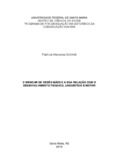| dc.creator | Schmitt, Patricia Menezes | |
| dc.date.accessioned | 2021-04-01T20:53:05Z | |
| dc.date.available | 2021-04-01T20:53:05Z | |
| dc.date.issued | 2019-08-30 | |
| dc.identifier.uri | http://repositorio.ufsm.br/handle/1/20482 | |
| dc.description.abstract | This dissertation aimed to analyze the evolution of play related to the cognitive, linguistic and motor development in infants between nine and 24 months, with and without psychic risk. The play analysis script was the instrument that guided the analysis of the filming of this research. This instrument evaluated the behaviors of the baby and the mother during play, and contemplated the verification of the cognitive and intersubjective aspects of the baby's play; and on the support and investment in playing on the part of the mother. The script was prepared by the researchers of this study, in the perspective of contemplating cognitive and intersubjective aspects in play. The study sample consisted of 32 full-term children, with 56.2% males and 43.8% females. Of these children, 13 presented psychic risk from the analysis of the IRDI script and seven children by the evaluation of the PREAUT Signals. The mean gestational age was 39 weeks. There was a significant difference in relation to the pleasure of the child in the experience with the object (p = 0.002), as well as the pleasure and maternal commitment in the activity of playing with the child (p = 0.010), with lower number of behaviors in the group with psychic suffering when compared to the group without psychic suffering. With regard to the creative use of the object, it was evident in this group that this category appears, after the group without suffering, around 18 months of age (p = 0.004), demonstrating effects of psychic risk on cognition and language. It can be concluded that there was an significant association between the characteristics of play and psychic suffering. There were descriptive differences regarding language, motor and cognition between the group with and without psychic suffering. | eng |
| dc.description.sponsorship | Coordenação de Aperfeiçoamento de Pessoal de Nível Superior - CAPES | por |
| dc.language | por | por |
| dc.publisher | Universidade Federal de Santa Maria | por |
| dc.rights | Attribution-NonCommercial-NoDerivatives 4.0 International | * |
| dc.rights.uri | http://creativecommons.org/licenses/by-nc-nd/4.0/ | * |
| dc.subject | Brinquedo | por |
| dc.subject | Desenvolvimento infantil | por |
| dc.subject | Linguagem | por |
| dc.subject | Cognição | por |
| dc.subject | Risco | por |
| dc.subject | Psiquismo | por |
| dc.subject | Play | eng |
| dc.subject | Child development | eng |
| dc.subject | Language | eng |
| dc.subject | Cognitivon | eng |
| dc.subject | Risk | eng |
| dc.subject | Mind | eng |
| dc.title | O brincar de bebês-mães e sua relação com o desenvolvimento psíquico, linguístico e motor | por |
| dc.title.alternative | Playing in babies from 9 to 24 months and its relationship with language and motor development, and psychic suffering | eng |
| dc.type | Dissertação | por |
| dc.description.resumo | Esta dissertação teve como objetivo analisar a evolução do brincar relacionado ao desenvolvimento cognitivo, linguístico e motor em bebês entre nove e 24 meses, com e sem risco psíquico. O roteiro do brincar norteou a análise das filmagens possibilitando a avaliação dos comportamentos do bebê e da mãe, durante o brincar, pela verificação dos aspectos cognitivos e intersubjetivos do brincar do bebê; e sobre sustentação e investimento no brincar por parte da mãe. O roteiro foi elaborado pelas pesquisadoras deste estudo, na perspectiva de contemplar os aspectos cognitivos e intersubjetivos no brincar. A amostra foi de 32 crianças nascidas a termo, sendo 56,2% do sexo masculino e 43,8% do feminino. Destas crianças, 13 apresentam risco psíquico a partir da análise do roteiro IRDI e sete crianças pela avaliação dos Sinais PREAUT. A média da idade gestacional foi de 39 semanas. Houve diferença significativa em relação ao prazer da criança na experiência com o objeto (p=0,002), bem como o prazer materno na atividade do brincar com o filho (p=0,010), com menor número de comportamentos no grupo em sofrimento psíquico quando comparado ao grupo sem sofrimento psíquico. Com relação ao uso criativo do objeto ficou evidente, neste grupo, que essa categoria aparece, posteriormente ao grupo sem sofrimento, por volta dos 18 meses (p=0,004), demonstrando efeitos do risco psíquico na cognição e linguagem. Pode-se concluir que houve associação significativa entre características do brincar e sofrimento psíquico. Houve diferenças descritivas quanto à linguagem, motricidade e cognição entre o grupo com e sem sofrimento psíquico. | por |
| dc.contributor.advisor1 | Moraes, Anaelena Bragança de | |
| dc.contributor.advisor1Lattes | http://lattes.cnpq.br/4262448037922838 | por |
| dc.contributor.advisor-co1 | Souza, Ana Paula Ramos de | |
| dc.contributor.advisor-co1Lattes | XXXXXXXXXXXXXX | por |
| dc.contributor.referee1 | Kruel, Cristina Saling | |
| dc.contributor.referee1Lattes | XXXXXXXXXXXXXXX | por |
| dc.contributor.referee2 | Fedosse, Elenir | |
| dc.contributor.referee2Lattes | XXXXXXXXXXXXXX | por |
| dc.creator.Lattes | http://lattes.cnpq.br/1133587384521849 | por |
| dc.publisher.country | Brasil | por |
| dc.publisher.department | Fonoaudiologia | por |
| dc.publisher.initials | UFSM | por |
| dc.publisher.program | Programa de Pós-Graduação em Distúrbios da Comunicação Humana | por |
| dc.subject.cnpq | CNPQ::CIENCIAS DA SAUDE::FONOAUDIOLOGIA | por |
| dc.publisher.unidade | Centro de Ciências da Saúde | por |



